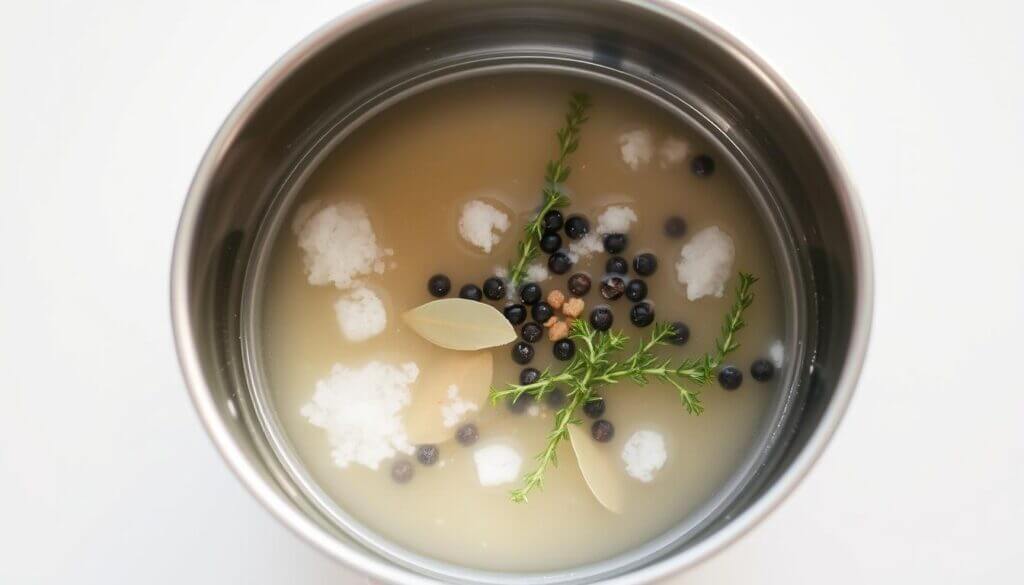Imagine the enticing aroma of succulent chicken thighs cooking. The anticipation builds as you prepare to savor each mouthful. Have you ever taken a bite of a juicy piece of chicken, only to feel the disappointment when it’s dry? You’re not alone.
Brining chicken thighs is your secret weapon to achieving perfectly juicy meat every time. This article will delve into how to brine chicken thighs. We’ll ensure they retain moisture, flavor, and heavenly juiciness that makes every meal memorable.
Learn the essential techniques, choose the right brine recipe, and master the brining process. Say goodbye to dry chicken and hello to a feast of flavors. This will have everyone coming back for seconds.
Key Takeaways
- Brining is essential for ensuring chicken thighs remain juicy and flavorful.
- A simple saltwater solution requires a 1/4 cup of kosher salt for every 4 cups of water.
- The optimal brining time for chicken thighs is between 4 to 6 hours.
- It’s crucial to use high-quality chicken thighs for the best brining results.
- Brining prevents excessive saltiness and mushiness if done correctly.
- Adding herbs and spices to your brine enhances the overall flavor of the meat.
- Maintain the brine at a cool temperature (35°F to 40°F) for optimal absorption.
Table of Contents
Why Brining is Important for Chicken Thighs
Brining is a key step in cooking chicken thighs. It makes the meat juicy and flavorful. By soaking the meat in salt water, it absorbs moisture and tastes better. Knowing how brining works helps you get the best texture and taste.
Understanding the Science of Brining
Brining adds salt to the chicken, making it absorb water. This is crucial for chicken thighs, as they need extra moisture. Bringing breaks down proteins, making the meat tender and juicy. Using the right brining methods brings out the best in chicken thighs.
Benefits of Moisture Retention
Brining keeps chicken thighs moist, up to 30% during cooking. This is especially true for bone-in, skin-on cuts. They stay juicy longer than boneless ones. Brining for about 3 hours helps keep the meat tender and juicy.
Flavor Enhancement through Brining
Brining also boosts flavor, adding about 20% more taste. Salt infuses the meat with deeper flavors. You can choose from wet, dry, or injection brining to fit your schedule and taste preferences.

| Brining Method | Moisture Retention | Flavor Enhancement | Recommended Time |
|---|---|---|---|
| Wet Brining | Up to 30% | 20% increase in savory notes | 3 hours for thighs |
| Dry Brining | Similar to wet brining | Comparable flavor depth | 2-3 hours for skin-on, bone-in |
| Injection Brining | Rapid flavor infusion | Quicker seasoning within 15 minutes | Immediate |
Choosing the Right Brine Recipe
Choosing the right brine recipe can make your chicken thighs better. There are many types of brines to pick from. This lets you adjust the flavor and moisture to your liking.
The classic saltwater brine is a good starting point. But you can also add your own to it.
Classic Saltwater Brine
The best brine for chicken thighs often starts with a classic saltwater recipe. A traditional ratio of 1/4 cup of kosher salt per 4 cups of water is effective for achieving moisture retention. Adding 1/4 cup of sugar counteracts the saltiness, balancing flavors and enhancing the overall taste. This brine recipe for chicken thighs suits those who appreciate simplicity while still benefiting from the brining process.
Adding Flavor with Herbs and Spices
Elevating your brine takes only a few extra ingredients. Incorporating herbs, such as thyme or rosemary, along with 2-3 cloves of garlic can create flavored brines that add depth to the chicken. You might experiment with spices and citrus fruits to develop unique profiles that delight your palate. The combination of salt, sugar, and various flavor boosters is pivotal for customizing your brine recipe for chicken thighs.
Sweet vs. Savory Brines
Choosing between sweet and savory brines can significantly alter your chicken’s flavor. Sweet brines typically include sugars like brown sugar or maple syrup, contributing a subtle sweetness that complements the meat. In contrast, savory brines focus on aromatic herbs, creating a different but equally delicious profile. Don’t hesitate to try both styles, as the outcomes can be rewarding, leading you closer to your ideal brined chicken.

Essential Ingredients for Brining
To make a great brine, you need to know the key ingredients. The secret to tender and tasty chicken is finding the right mix. Start with salt and water, but don’t forget to add other flavors to make it special.
Key Components of a Brine
A brine’s base is salt and water mixed into a 4-6% salt solution. Kosher salt is best because it dissolves easily. This mix helps the meat soak up moisture and flavor, making it juicy and tender.
Using the right brine can keep up to 40% more moisture in the chicken. This means your meat will be tender and full of flavor.
Optional Ingredients for Flavor Boost
Want to add more taste to your brine? Try garlic, rosemary, thyme, and brown sugar. These extras can make your chicken taste even better. Feel free to mix and match to find your favorite flavors.
Selecting High-Quality Chicken Thighs
Choosing the right chicken is important, too. Go for fresh, plump chicken thighs, whether they have bones or not. Good chicken absorbs the brine better, making your meal even more delicious.

How to Prepare Your Brine
Creating the perfect brine is all about careful preparation. It’s key to get the saltwater ratio right for the best flavor and moisture in your chicken thighs. A classic brine recipe has salt, sugar, water, and aromatic ingredients to boost the flavor.
Measuring the Salt and Water Ratio
The right salt-to-water ratio is crucial for a great brine. A common rule is 1 cup of kosher salt for every gallon of water. For smaller batches, use 4 cups of water and ¼ cup of kosher salt. This mix gives a balanced taste without overpowering the meat.
Mixing in Additional Flavorings
Adding extra flavorings can make your chicken thighs taste amazing. You can add garlic, bay leaves, black peppercorns, thyme, and rosemary to the brine. Make sure to mix these well so their flavors blend into the brine, making it rich and meat-penetrating.
Ensuring the Brine is Cool Before Use
It’s important to cool the brine before using it. A hot brine can cook the meat, changing its texture. Let the brine cool down completely before adding your chicken. This step makes the brine work better and keeps the chicken tender.

Bringing Techniques: Time and Method
Brining chicken thighs can boost their flavor and texture. Knowing the right brining time and method is key. Whether you’re short on time or want to refine your skills, there are options for you.
How Long Should You Brine?
The best brining time for chicken thighs is between 30 minutes and 2 hours. A quick 15-minute brine adds a touch of saltiness without drying out the meat. Brining for 30 minutes makes the chicken slightly tender.
Brining for 1 hour strikes a perfect balance of flavor and juiciness. Bringing it for 2 hours makes the chicken very juicy. But be careful not to make it too salty without a good sauce.
Overnight vs. Quick Brining
Quick brining is great for those in a hurry but still want tasty chicken. It’s a good choice when time is tight. On the other hand, overnight brining lets the meat soak up more flavor and stay moist.
But don’t brine for more than four hours. After that, the chicken might taste too salty and become too moist, like deli meat.
Method: Submerging vs. Injecting Brine
There are two main brining methods: submerging the meat in brine or injecting it. Submerging is the traditional way and ensures the chicken absorbs all the flavors. You’ll need six tablespoons of kosher salt and 4 cups of cold water for this.
Injecting brine, however, is faster. It injects flavor directly into the meat. This way, even the inside parts get seasoned without needing to brine for a long time.
Tips for Brining Chicken Thighs
Brining chicken thighs needs a mix of salt and time for the best taste and texture. Here are some tips to help you brine chicken thighs well. This will make your cooking experience enjoyable.
Checking for Proper Salt Balance
Getting the salt balance right is key when bringing chicken thighs. Too much salt makes it taste bad, while too little makes it taste bland. A good mix is 1 part kosher salt to 2 parts sugar with 16 parts water. Always check the brine to make sure it’s right.
Preventing Over-Brining
It’s important to watch the brining time to prevent over-brining. For the best results, brine for 30 minutes to 4 hours, depending on the chicken’s thickness. Brining for 6 to 8 hours can make the chicken too soft. Check the chicken often to keep it tender and juicy.
Tips for Brining in Different Seasons
Bringing in different seasons can make your chicken taste better. In warm months, add fresh herbs like basil and thyme. In cold months, use spices like cinnamon or allspice. This way, your chicken will always taste fresh and exciting.
| Rich flavor, slightly on the edge of being salty. | Expected Results |
|---|---|
| 30 Minutes | Lightly salted; no noticeable change in texture. |
| 1 Hour | Perfectly seasoned, juicy, and tender. |
| 2 Hours | Rich flavor; slightly on the edge of being salty. |
| 4 Hours | Considered too salty for direct consumption. |
Rinsing and Drying After Brining
Rinsing chicken thighs after brining is crucial for food safety and better cooking. Chefs rinse to remove extra salt and kill surface bacteria. Then, drying is key to prevent moisture and ensure a juicy dish.
Why Rinsing is Necessary
Rinsing cuts down on saltiness, making the chicken taste milder. It also removes leftover spices and brine. The clean chicken cooks more evenly and tastes better.
Proper Drying Techniques
Use paper towels to dry the chicken well after rinsing. This helps get a good sear when cooking. Dry it until no moisture is left. You can also air-dry it in the fridge for up to 12 hours for a crispy crust.
Avoiding Excess Moisture
Keeping the chicken dry is essential for a great texture. Moisture can make it steam instead of brown, ruining the dish. Dry it well and store it right before cooking. These steps make your brined chicken thighs taste amazing.
Cooking Brined Chicken Thighs
Cooking brined chicken thighs can make your meal truly special. The flavors and moisture they retain make them incredibly juicy. You can grill or bake them, each method bringing its benefits for juiciness and flavor.
Best Cooking Methods for Juiciness
The method you choose affects the chicken’s moisture. Grilling adds a smoky taste that pairs well with the brine. Baking ensures even cooking, making every thigh tender and juicy. Both methods help the brine enhance the chicken’s juiciness.
Recommended Cooking Temperatures
For the best results, cook your chicken thighs to an internal temperature of 165°F. This ensures they are safe to eat and stay juicy. Keeping an eye on the temperature helps balance moisture and flavor.
Grilling vs. Baking: What to Choose?
Deciding between grilling and baking depends on your taste and cooking style. Grilling gives a smoky flavor that many love, especially with a flavorful brine. Baking offers more control over cooking, resulting in evenly cooked, tender thighs. Think about your preferences, available equipment, and desired outcomes when choosing how to cook your brined chicken thighs.
Flavor Pairings for Brined Chicken Thighs
To make your brined chicken thighs even better, try different flavor pairings. Side dishes, sauces, and drinks all play a part in bringing out the taste. Mixing textures and flavors makes your meal more exciting.
Complementary Side Dishes
Choosing the right side dishes can make your meal better. Here are some great options that go well with brined chicken thighs:
- Roasted vegetables like carrots, Brussels sprouts, and bell peppers
- Mashed potatoes with garlic or herbs on top
- Rice pilaf with nuts and dried fruits
- Fresh green salad with a tangy vinaigrette
Sauces That Work Well
Adding sauces can change your dish for the better. Here are some tasty options:
- Lemon butter sauce for a bright, zesty taste
- Classic BBQ sauce for a smoky, sweet flavor
- Garlic herb sauce to boost the savory taste
- Fruity salsa, like mango or peach, for a refreshing twist
Wine and Beverage Pairings
The right drinks can balance your meal and highlight the flavors of brined chicken thighs. Here are some good choices:
- Crisp Sauvignon Blanc for its acidity
- Light-bodied Pinot Noir to match the seasoning
- Craft beer with citrus notes to add to the taste
- Refreshing iced tea with lemon for a non-alcoholic option
Each of these choices helps create a balanced and enjoyable meal. Your dinner will surely be unforgettable.
Storing Leftover Brined Chicken
Managing leftover brined chicken thighs well keeps them fresh and flavorful. Good refrigeration methods help keep your chicken good for a long time. Using the right techniques ensures your dish stays tasty and safe to eat.
Best Practices for Refrigeration
Store leftover chicken thighs in an airtight container for the best freshness. This keeps moisture in and flavors intact. Cooked brined chicken stays good in the fridge for up to three days. For longer storage, freeze it for about three months.
Reheating Techniques for Moisture Retention
There are several ways to reheat chicken without drying it out. Preheat your oven to 350 degrees F (180 degrees C). Reheat the chicken for 12 to 15 minutes. This ensures it’s hot and safe to eat.
You can also gently pan-fry it. This method adds moisture and brings out more flavors.
Keeping Flavors Intact
It’s important to keep the flavors of your chicken after refrigeration or freezing. Always store your chicken to avoid freezer burn or picking up odors. When reheating, add a bit of seasoning to bring back the brined flavors.
Troubleshooting Common Issues
Brined chicken can sometimes present challenges like saltiness and texture inconsistencies. Understanding how to manage these issues will enhance your culinary experience. Here are some tips for troubleshooting brined chicken effectively.
What if the Chicken is Too Salty?
If your chicken is too salty, try pairing it with milder side dishes or sauces. Grains, vegetables, or creamy sauces can help balance the flavors. You can also rinse the chicken before cooking or serve it with a citrus-based dressing to cut through the salt taste.
Dealing with Texture Problems
Texture issues often stem from over-brining. If your chicken feels too mushy, it might be from too much time in the brine. To fix this, use sauces to mask any unwanted textures and add moisture. A crispy breading during cooking also helps create a nice contrast.
Adjusting Flavors After Cooking
If the final dish is unbalanced after cooking, adding fresh herbs or a squeeze of lemon can invigorate the flavor. These adjustments can revitalize the dish and address any overwhelming saltiness. Herbal notes not only brighten the flavors but also enhance the overall appeal of your brined chicken.
| Common Issues | Possible Solutions |
|---|---|
| Too Salty | Pair with milder sides, rinse before cookingor use citrus-based dressings. |
| Texture Problems | Incorporate sauces and focus on crispy breading for contrast. |
| Flavor Imbalance | Add fresh herbs or citrus for a flavor boost. |
Conclusion: Perfecting Your Brining Technique
Learning to brine chicken thighs is a fun journey for anyone who loves tasty meals. Don’t be shy about trying new flavors. Add herbs, spices, or citrus zest to your brine. This way, you can find the perfect mix that you love.
Remember, it brings amazing benefits. It can make your chicken juicy and full of flavor. Whether you use a saltwater brine or dry brine, it’s all about keeping your chicken moist. With the tips from this article, you’re ready to make every dish delicious.
Always keep practicing your bringing skills. Cooking is about having fun, being creative, and sharing meals with others. So, next time you cook, use what you’ve learned. Turn simple chicken thighs into something amazing that everyone will enjoy.

